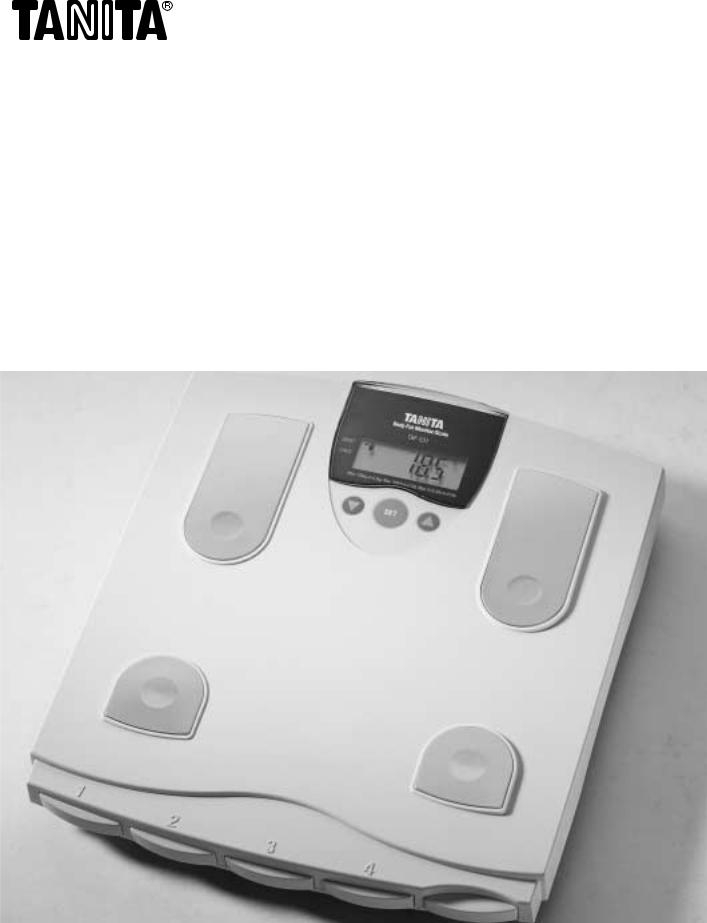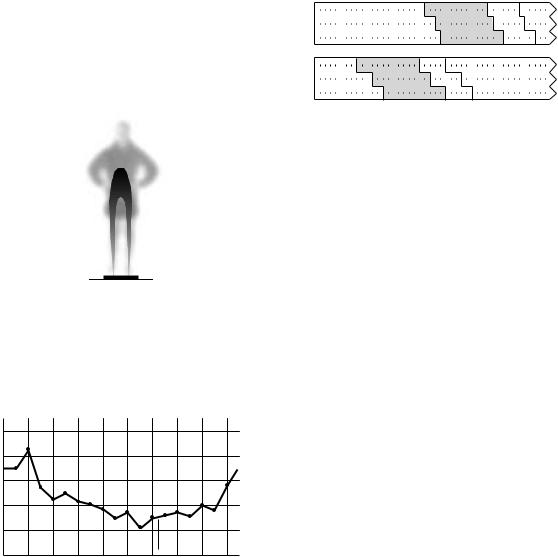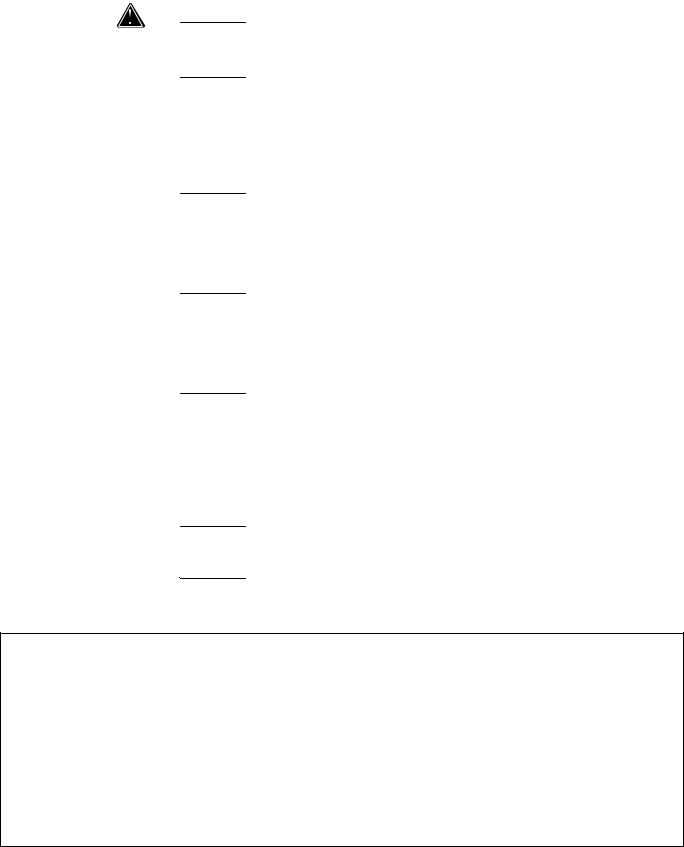Tanita TBF-531 User Manual

TBF-531BODY FAT MONITOR/SCALE
Instruction Manual

ENGLISH: Operating Instructions
Thank you for your selection of the TANITA Body Fat Monitor/Scale TBF-531. This family model uses the BIA (Bioelectrical Impedance Analysis) technique, a state-of-the-art technology for body fat measurement.
NOTE: Read this Instruction Manual carefully and keep it handy for future reference.
Safety precautions
•Persons with implanted medical equipment, such as a pacemaker, should not use the TBF-531. This Body Fat Monitor/Scale passes a very low electrical signal through the body during measurement, which may interfere with the operation of a pacemaker.
•The TANITA Body Fat Monitor/Scale TBF-531 is intended for home use only. This unit is not intended for professional use in hospitals or other medical facilities. It is not equipped with the quality standards required for professional use.
•Do not use this unit on slippery surfaces such as tile flooring or wet floors.
•Children or disabled people should be assisted by someone else, or use a handrail when using the TBF-531.
NOTE: Measurements will vary with the amount of moisture in the body, and can be affected by dehydration caused by such things as alcohol consumption, menstruation, illness, strenuous exercise, etc.
Important notes for users
The TBF-531 is intended for use by male and female adults and by children up to the age of 18, over 3.6 ft. (107 cm) tall, whose bodies are still developing. Body fat percentage measurements may be slightly lower or higher for the following categories of people:
•Children seven years old or younger
•Adults seventy years old or older
•Pregnant women
•Persons undergoing dialysis
•Persons suffering from edema
Body fat percentage measurements for these persons should not be treated as absolute values, but may be used as relative values for checking body fat percent variations over a period of time.
The TBF-531 is not intended for use by persons involved in intense aerobic exercise of at least 10 hours per week and who have a resting heart rate of less than 60 beats per minute. It is also not intended for professional athletes or bodybuilders who may experience physical changes due to dehydration.
Recommendations for exercise programs or diets based on measured data should be determined by a doctor or licensed medical professional. Do not attempt to evaluate the data by yourself.
Recorded data may be lost if the TBF-531 is used incorrectly or is exposed to electrical power surges. TANITA takes no responsibility for any kind of loss caused by the loss of recorded data.
TANITA takes no responsibility for any kind of damage or loss caused by these units, or any kind of claim made by a third person.
1

Tanita TBF-531 Body Fat Monitor/Scale
Principles of body fat percentage measurement
Tanita’s patented “foot-pad” design sends a safe, low-level electrical signal through the body to determine its composition.
Body Fat %
22 |
|
|
|
|
|
21 |
|
|
|
|
|
20 |
|
|
|
|
|
19 |
|
|
|
|
|
18 |
|
|
|
|
|
17 |
|
|
|
|
|
6 am |
10 am |
2 pm |
6 pm |
10 pm |
Time |
Daily fluctuations in body fat percentage based on the BIA method
The Tanita Body Fat Monitor/Scale TBF-531 allows you to estimate your body fat percentage at home as easily as you measure your weight.
What is body fat percentage?
Body fat percentage is the percentage of fat in your body. Until now, your absolute weight has determined whether or not you were considered overweight or obese. In recent years, the definition of obesity has been refined to mean the presence of excess body fat. Too much body fat has been linked to conditions such as high blood pressure, heart disease, diabetes, cancer, and other disabling conditions.
Body Fat Ranges for Standard Adults1, 2
|
|
|
Underfat |
|
|
Healthy |
Overfat |
|
Obese |
|||
Female 20–39 |
|
|
|
|
|
|
|
|
|
|
|
|
|
|
|
|
|
|
|
|
|
|
|
||
|
|
|
|
|
|
|
|
|
|
|
|
|
Age 40–59 |
|
|
|
|
|
|
|
|
|
|
|
|
|
|
|
|
|
|
|
|
|
|
|
||
|
|
|
|
|
|
|
|
|
|
|
|
|
60–79 |
|
|
|
|
|
|
|
|
|
|
|
|
|
|
|
|
|
|
|
|
|
|
|
||
0% |
10% |
20% |
30% |
|
|
40% |
||||||
Male 20–39 |
|
|
|
|
|
|
|
|
|
|
|
|
|
|
|
|
|
|
|
|
|
|
|
||
|
|
|
|
|
|
|
|
|
|
|
|
|
Age 40–59 |
|
|
|
|
|
|
|
|
|
|
|
|
|
|
|
|
|
|
|
|
|
|
|
||
|
|
|
|
|
|
|
|
|
|
|
|
|
60–79 |
|
|
|
|
|
|
|
|
|
|
|
|
|
|
|
|
|
|
|
|
|
|
|
||
|
|
Underfat |
Healthy |
Overfat |
|
Obese |
|
|
||||
1Based on NIH/WHO BMI Guidelines.
2As reported by Gallagher, et al., at NY Obesity Research Center.
To determine the percentage of body fat that is appropriate for your body, consult your physician.
The BIA method
The TBF-531 uses the BIA (Bioelectrical Impedance Analysis) technique. In this method, a safe low-level electrical signal is passed through the body. It is difficult for the signal to flow through fat in the human body, but easy to flow through moisture in the muscle and other body tissues. The difficulty with which a signal flows through a substance is called impedance. So the amount of fat in the body can be accurately estimated by measuring the impedance. The signal used is very low, making it safe and imperceptible.
The illustration on the left show how the signal travels through the body.
Body fat percentage fluctuations in a day
Hydration levels in the body may affect body fat readings. Readings are usually highest in the early waking hours, since the body tends to be dehydrated after a long night’s sleep. For the most accurate reading, a person should take a body fat percentage reading at a consistent time of day under consistent conditions.
Besides this basic cycle of fluctuations in the daily body fat readings, variations may be caused by hydration changes in the body due to eating, drinking, menstruation, illness, exercising, and bathing. Daily body fat readings are unique to each person, and depend upon one’s lifestyle, job and activities.
The graph on the left shows an example of daily body fat percentage fluctuations.
Advantages of the Tanita TBF-531
Previously, body fat percentage was determined by measuring the thickness of subcutaneous fat by pinching it with calipers, or by laying a person on a scanning bed and passing a current from hand to foot. However, these methods had problems; measurement values varied, professional skills were required, and extensive time was required for measurement. Currently, the standard methods of fat percentage measurement are DEXA (dual energy x-ray absorptiometry) and Hydrodensitometry (underwater weighing).
Based on data from both the DEXA and underwater weighing methods, Tanita established a formula for estimating the percentage of body fat. There is a high correlation between measurements taken with the TBF-531 and those obtained through DEXA and underwater weighing.
2

Table of contents
1 |
Safety precautions |
|
Important notes for users |
2 |
Principles of body fat percentage measurement |
|
What is body fat percentage? |
|
Reasonable ranges of body fat percentage |
|
Body fat percentage measurement |
|
Body fat percentage fluctuations in a day |
|
Advantages of the TANITA Body Fat Monitor/Scale TBF-531 |
4 |
Features and functions of the TBF-531 |
|
Components |
|
Measuring platform |
|
Accessories |
|
Useful features of the TBF-531 |
6 |
Preparations before use |
|
Inserting the batteries |
|
Positioning the unit |
|
Attaching the support feet |
|
Handling tips |
7 |
How to measure body fat percentage |
|
Overview of measuring |
|
Setting and storing data in memory |
|
Taking measurements |
|
Taking weight measurement only |
|
Changing values in memory |
|
Replacing the batteries |
10 |
Troubleshooting |
|
Specifications |
11 |
Warranty |
FEDERAL COMMUNICATIONS COMMISSION NOTICE
This equipment has been tested and found to comply with the limits for a Class B digital device, pursuant to Part 15 of the FCC Rules. These limits are designed to provide reasonable protection against harmful interference in a residential installation. This equipment generates, uses and can radiate radio frequency energy and, if not installed and used in accordance with the instructions, may cause harmful interference to radio communications. However, there is no guarantee that interference will not occur in a particular installation. If this equipment does cause harmful interference to radio or television reception, which can be determined by turning the equipment off and on, the user is encouraged to try to correct the interference by one or more of the following measures:
•Reorient or relocate the receiving antenna.
•Increase the separation between the equipment and receiver.
•Connect the equipment into an outlet on a circuit different from that to which the receiver is connected.
•Consult the dealer or an experienced radio or television technician for help.
Modifications
The FCC requires the user to be notified that any changes or modifications made to this device that are not expressly approved by Tanita Corporation may void the user’s authority to operate the equipment.
3
